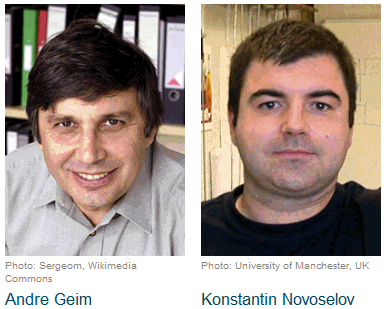|
|
|
|
|
|
|
News & Views item - October 2010 |
![]() Discoverers
of Graphene Awarded Nobel Physics Prize. (October 6, 2010)
Discoverers
of Graphene Awarded Nobel Physics Prize. (October 6, 2010)
The Royal Swedish Academy of Sciences has announced that it has decided to award the Nobel Prize in Physics for 2010 to Andre Geim (51) and Konstantin Novoselov (36) of the University of Manchester, UK "for groundbreaking experiments regarding the two-dimensional material graphene".

The Royal Swedish Academy's announcement states: "Graphene – the perfect atomic lattice [is a] thin flake of ordinary carbon, just one atom thick. [It] lies behind this year’s Nobel Prize in Physics. Andre Geim and Konstantin Novoselov have shown that carbon in such a flat form has exceptional properties that originate from the remarkable world of quantum physics."
|
|
|
Professors Geim and Novoselov first produced flakes of graphene by peeling them off a piece of graphite using Sellotape. "It just started as a Friday evening experiment," Novoselov recalls. "We were enjoying doing it." Philip Kim, a physicist at Columbia University told Science: "I was shocked that they were able to get a single layer with such a simple method; we were completely scooped."
The two-dimensional properties of graphene were of immediate interest to theoretical physicists. For example, its electrons tend to move as though they are massless, like photons, thereby confirming the predictions of the quantum behavior expected by the theorists. As a consequence, graphene "is flexible like plastic but stronger than diamond, and it conducts electricity like a metal but is transparent like glass".
Since its discovery six years ago, scientists and engineers have developed methods to make sheets measuring tens of centimetres across, methods to cut the sheets into nanometre-scale patterns and methods to alter its electrical properties, for example, by hydrogenating it.
At the moment graphene is seen to have enormous potential in electronics and it is even being considered as part of new means of DNA sequencing because of its pore size and electrical properties.
____________________________________
In an interview for the Guardian Professor Novoselov said Britain risks losing senior figures and rising stars in science if funding cuts materialise in the government's spending
|
|
review: "Without money we won't be able to attract good people here. The impact is going to be that good scientists will go abroad, especially the young people."
Both Professors Geim and Novoselov were born in Russia and collaborated as PhD supervisor and student in the Netherlands before moving to Manchester University.
It is noteworthy that according to the Nobel committee: "Playfulness* is one of their hallmarks. With the building blocks they had at their disposal they attempted to create something new, sometimes even by just allowing their brains to meander aimlessly," while Professor Brian Cox, a particle physicist at also Manchester University and working at Cern commented: "I remember when Andrei Geim started at Manchester in 2001. At that time, UK universities were just beginning to feel the effects of the government's enhanced commitment to science: the mood was optimistic and universities were looking to hire the best young scientists from across the world. Andrei was such a scientist, and together with Konstantin Novoselov, they have received the highest award in international science for the curiosity-driven discovery of graphene, a material that has the potential to change the world and generate immense economic benefits. This is what UK science is all about – a world-leading success story that must be treasured and supported for the future."
Is it too much to ask that Australia's responsible ministers as well as other parliamentarians might take note?
____________________________
*In 2000, Andre Geim won a share of the Ig Nobel Prize in: PHYSICS Andre Geim of the University of Nijmegen (the Netherlands) and Sir Michael Berry of Bristol University (UK), for using magnets to levitate a frog. [REFERENCE: "Of Flying Frogs and Levitrons" by M.V. Berry and A.K. Geim, European Journal of Physics, v. 18, 1997, p. 307-13.].
To date this is an unique double.